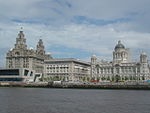Welsh Presbyterian Church, Liverpool
| Welsh Presbyterian Church, Liverpool | |
|---|---|
 The former church in April 2024 | |
| 53°23′38″N 2°57′50″W / 53.3938°N 2.9638°W | |
| OS grid reference | SJ 360 890 |
| Location | Princes Road, Liverpool, Merseyside |
| Country | England |
| Denomination | Presbyterian Church of Wales |
| Architecture | |
| Functional status | Redundant |
| Heritage designation | Grade II |
| Designated | 14 March 1975 |
| Architect(s) | W. & G. Audsley |
| Architectural type | Church |
| Style | High Victorian Gothic |
| Groundbreaking | 1865 |
| Completed | 1867 |
| Specifications | |
| Spire height | 200 feet (61 m) |
| Materials | Stone, slate roof |
The Welsh Presbyterian Church is a disused church on Princes Road in the Toxteth district of Liverpool, Merseyside, England. It is a redundant church of the Presbyterian Church of Wales, and is recorded in the National Heritage List for England as a designated Grade II listed building.[1] Because of its tall steeple, the church has been nicknamed the "Welsh Cathedral", or "Toxteth Cathedral", although it was never an actual cathedral.[2] In 2019, it received National Lottery Stage 1 funding to become a community hub after thirty years abandonment.[3]
History
[edit]The church was built between 1865 and 1867, and designed by the local architects W. & G. Audsley.[1] At the time it was built, because of its steeple rising to a height of 200 feet (61 m), it was the highest building in Liverpool.[2] In 1982, when it was no longer used as a Welsh Presbyterian Church, it was sold to the Brotherhood of the Cross and Star, a religious organisation with headquarters in Nigeria. They ceased to use the church in the 1990s, it became vacant, was vandalised, and became derelict.[4] There were plans for the leasehold to be acquired by a partnership of the Merseyside Building Preservation Trust and the Heritage Trust for the North West.[4][5] As of 2013 the Merseyside Building Preservation Trust is undertaking a feasibility study with the intention to make a bid for a grant from the Heritage Lottery Fund.[2]
Naming
[edit]The denomination was created in 1811 and formalized in 1823 as the Welsh Calvinistic Methodists. See Welsh Methodist revival and Calvinistic Methodists. From 1928 on, the denomination was also known as the Presbyterian Church in Wales. So this church, and other buildings may be called Methodist, Calvinist or Presbyterian, but belong to the same establishment (or actually Disestablishment).
Architecture
[edit]The church is constructed in rock-faced rubble, and has a patterned slate roof. It is in High Victorian Gothic style.[1] The church consists of a nave and transepts, giving it a T-shaped plan.[6] The tower has angle buttresses, which have niches at the top. The bell openings are paired and louvred. On top of the tower are pinnacles and a broach spire with arcading and lucarnes. Attached to the south transept is a canted stair tower. On top of the crossing is a slate flèche. Inside the church are galleries at the west end and in the transepts, which are carried on marble piers. The nave has a barrel roof supported by wall piers.[1]
See also
[edit]References
[edit]- ^ a b c d Historic England, "Welsh Presbyterian Church, Liverpool (1355050)", National Heritage List for England, retrieved 27 September 2013
- ^ a b c Weston, Alan (24 September 2013), "Toxteth's Welsh Presbyterian Church may have new lease of life", Liverpool Echo, retrieved 27 September 2013
- ^ Traynor, Luke (13 July 2019). "Abandoned for 30 years now Toxteth's Welsh church will get a new lease of life". liverpoolecho.
- ^ a b Neild, Larry (3 November 2009), "Third cathedral hangs onto a £1 prayer", Liverpool Confidential, Confidential Publishing, archived from the original on 11 May 2012, retrieved 27 September 2013
- ^ Bartlett, David (9 November 2009), "Liverpool's 'Welsh Cathedral' saved by ECHO's Stop The Rot campaign", Liverpool Echo, archived from the original on 11 October 2012, retrieved 27 September 2013
- ^ Sharples, Joseph; Pollard, Richard (2004), Liverpool, Pevsner Architectural Guides, New Haven and London: Yale University Press, p. 249, ISBN 0-300-10258-5
External links
[edit]- Presbyterian Church of Wales
- Churches in Liverpool
- Churches completed in 1867
- 19th-century Presbyterian churches
- Grade II listed buildings in Liverpool
- Grade II listed churches in Merseyside
- Gothic Revival church buildings in England
- Gothic Revival architecture in Merseyside
- 19th-century church buildings in England
- Welsh diaspora in England





